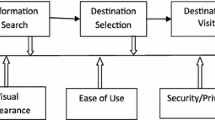Abstract
This paper has two research objectives. First, it adopts the Information, Communication, Transaction, Relationship, and Technical Merit model to evaluate Destination Marketing Organization (DMO) web sites from five East Asian countries. Second, it examines the relationship between website complexity and performance. The results indicate that the five selected DMO websites have not fully utilized information technology in their business operations. All five websites have performed reasonably well on the information and communication dimensions. However, three web sites perform poorly in the transaction dimension. Among the five selected countries, the Korean DMO’s website received the highest score for effectiveness, followed by the Japanese, Thai, and Hong Kong websites. The Macau DMO’s website received the lowest score for effectiveness. In addition to evaluating website effectiveness, this study found a linear relationship between website complexity and performance. Also there are significant performance variances among the DMOs’ websites across different countries.

Similar content being viewed by others
References
Agarwal R, Venkatesh V (2002) Assessing a firm’s web presence: a heuristic evaluation procedure for the measurement of usability. Info Syst Res 13(2):168–186
Chiou WC, Lin CC, Perng C (2011) A strategic website evaluation of online travel agencies. Tour Manag 32(6):1463–1473
Chung J, Tan FB (2004) Antecedents of perceived playfulness: an exploratory study on user acceptance of general information-searching websites. Info Manag 41(7):869–881
Day A (1999) A model for monitoring web site effectiveness. Internet Res Electron Netw Appl Policy 7(2):109–115
Devaraj S, Fan M, Kohli R (2002) Antecedents of B2C channel satisfaction and preference: validating e-Commerce metrics. Info Syst Res 13(3):316–333
Dholakia UM, Rego LL (1998) What makes commercial Web pages popular? An empirical investigation of Web page effectiveness. Eur J Mark 32(7):724–736
Doolin B, Burgess L, Cooper J (2002) Evaluating the use of the web for tourism marketing: a case study from New Zealand. Tour Manag 23(5):557–561
Dutta S, Segev A (1999) Business transformation on the internet. Eur Manag J 17(5):466–476
Feng R, Morrison AM, Ismail JA (2003) East versus west: a comparison of online destination marketing in China and the U.S. J Vacat Mark 10(1):43–56
Grant M (2013) The 25 most popular destinations for Chinese tourists, Euromonitor International. http://skift.com/2013/09/03/top-25-most-popular-destinations-for-chinese-tourists/
Hu C, Han YX, Jang SC, Bill B (2005) E-relational characteristics on hospitality and tourism program web sites. J Hosp Tour Res 29(2):508–516
Ip C, Law R, Lee HA (2011) A review of website evaluation studies in the tourism and hospitality fields from 1996 to 2009. Int J Tour Res 13(3):234–265
Law R, Hsu C (2005) Customers perceptions on the importance of hotel website dimensions and attributes. Int J Contemp Hosp Manag 17(6/7):493–503
Lee JK, Morrison AM (2010) A comparative study of website performance. J Hosp Tour Technol 1(1):50–67
Li X, Wang Y (2010) Evaluating the effectiveness of destination marketing organizations’ websites: evidence from China. Int J Tour Res 12(5):536–549
Li X, Wang Y (2011) Measuring the effectiveness of US official state tourism websites. J Mark 17(4):287–302
Morrison AM, Morrison AJ, Morrison AD, Taylor JS (1999) Marketing small hotels on the World Wide Web. Inf Technol Tour 2(2):104–125
Morrison AM, Taylor J, Douglas A (2004) Website evaluation in tourism and hospitality: the art is not yet stated. J Travel Tour Mark 17(2/3):233–251
Palmer A, McCole P (2000) The role of electronic commerce in creating virtual tourism destination marketing organizations. Int J Contemp Hosp Manag 2000:198–204
Poon A (1993) Tourism, technology and competitive strategies. CAB International, Wallingford
Qi S, Buhalis D, Law R (2007) Evaluation of the usability on Chinese destination management organisation websites. In: Sigala M, Mich L, Murphy J (eds) Information and Communication Technologies in Tourism 2007 New York. Springer, Wien, pp 267–278
Rita P (2000) Web marketing tourism destinations. In: ECIS, pp 1096–1103, January 2000
Schmidt S, Cantallops AS, Santos CP (2008) The characteristics of hotel websites and their implications for website effectiveness. Int J Hosp Manag 27(2):504–516
Sharma A (2002) Trends in internet-based business to- business marketing. Ind Mark Manag 31(2):77–84
Siguaw JA, Enz CA, Namasivayam K (2000) Adoption of information technology in U.S. hotels: strategically driven objectives. J Travel Res 39(2):192–201
Starkov M, Price J (2006) Hotelier’s 2006 top ten internet marketing resolutions. Retrieved from: http://www.hospitalityebusiness.com
Tan GW, Wei KK (2006) An empirical study of web browsing behaviour: towards an effective website design. Electron Commer Res Appl 5(1):261–271
Vogt CA (2010) Customer relationship management in tourism: management needs and research applications. J Travel Res 50(4):356–364
Wang Y (2008) Web-based destination marketing systems: assessing the critical factors for management and implementation. Int J Tour Res 10(1):55–70
Wang Y, Russo SM (2007) Conceptualizing and evaluating the functions of destination marketing systems. J Vacat Mark 13(3):187–203
Wilgen JV (2009) 66% of US leisure travelers use internet to plan some aspect of their travel. Retrieved from: http://www.tourismroi.com/InteriorTemplate.aspx?ID=32418
Yeung TA, Law R (2006) Evaluation of usability: a study of hotel web sites in Hong Kong. J Hosp Tour Res 30(4):452–473.
Yuan YL, Gretzel U, Fesenmairer DR (2006) The role of information technology use in American convention and visitors Bureaus. Tour Manag 27(2):326–421
Author information
Authors and Affiliations
Corresponding author
Rights and permissions
About this article
Cite this article
Pai, CK., Xia, M.L. & Wang, TW. A comparison of the official tourism website of five east tourism destinations. Inf Technol Tourism 14, 97–117 (2014). https://doi.org/10.1007/s40558-014-0007-7
Received:
Revised:
Accepted:
Published:
Issue Date:
DOI: https://doi.org/10.1007/s40558-014-0007-7




